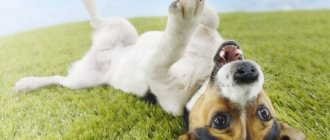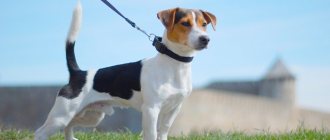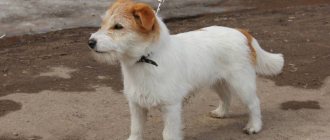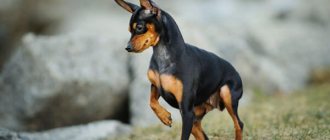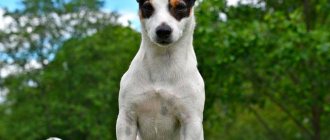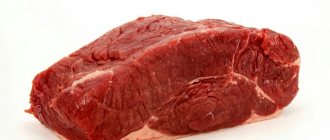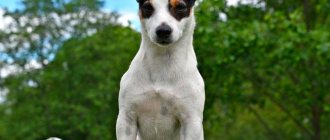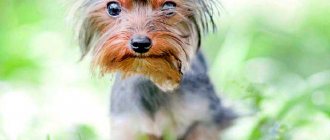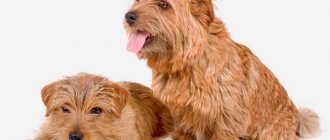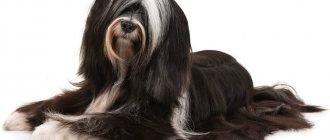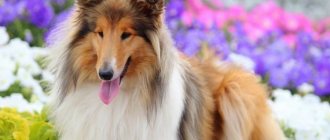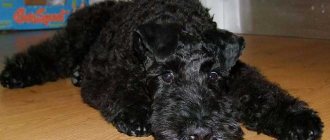Active, playful, courageous and nimble - all this accurately characterizes the Parson Russell Terrier breed.
Bred for hunting, they are excellent at their task, but at the same time they can be loving friends and faithful companions, family favorites and the life of the party.
These dogs are unpretentious to their living conditions, they obey commands perfectly, but they require maximum physical exertion, otherwise their internal energy will “overflow.”
History of the Parson Russell Terrier breed
The Parson Russell Terrier is one of the few breeds in whose pedigree there are no white spots, despite the fact that its roots go back to the 18th century. Moreover, history has preserved the name of the creator of the “Parsons,” who was the English pastor John Russell from Devon. In his youth, the monk loved hunting on horseback, so he set out to breed a dog that would accompany the rider on his trophy trips.
Russell chose terriers as the basic breeding material, which he initially tried to cross with other breeds. Soon the pastor got tired of messing around with puppies that showed no promise in terms of work, and he began breeding all varieties of terriers in a row. The breeder-enthusiast did not focus on the exterior of his own pets, preferring to pay attention to the hunting inclinations of the litters, so the first “Parsons” could not boast of an expressive and uniform appearance.
Until about the middle of the 20th century, the Parson Russells remained in the shadow of their more successful relatives in the group. Dogs were bred and hunted with, but they were in no hurry to standardize them. It is unknown how long this neglect on the part of cynological associations would have continued if World War II had not broken out in Europe, during which Reverend Russell’s dogs began to be exported to the USA and countries of the Eurasian continent, which made them more popular.
However, the military actions had little effect on the formalities associated with entering the breed into the stud books, so for more than forty years the dogs did not have their own standard. The first step towards registering Parson Russell Terriers was taken by the English Kennel Club, which in 1990 developed a temporary appearance standard for the pastor’s charges. However, the official recognition of the FCI for the breed came only in 2001.
History of the origin of the species
The Jack Russell Terrier breed is on everyone's lips after the release of the film "The Mask".
This breed was bred in the 19th century by an English clergyman from the county of Devonshire. His name was John, but for some reason the parishioners nicknamed him Jack, hence the name of the breed. This minister was fond of fox hunting. He bred and crossed terriers of different breeds with each other in order to obtain the ideal hunting assistant.
The result is a dog that can crawl into any hole perfectly, has sharp eyesight and a sensitive sense of smell. In fact, the breed he bred is a fox terrier of especially large size.
Parson Russell Terrier breed standard
Parson Russells are very similar to Jack Russell Terriers, which is no coincidence - the breeds have common ancestors, and until 2001 they generally had to share one standard of appearance between two. And yet there are exterior differences between representatives of both families. For example, Parsons are slightly taller than Jacks and have an almost square body shape, while their counterparts have a distinctly rectangular body. Leg length is also considered a breed characteristic. Parson Russell Terriers have longer limbs than the stocky, compact Jack Russells.
Head
The Parson Russell Terrier's skull is flat, moderately wide, slightly tapering at the muzzle. The stop is small and smooth.
Jaws and bite
The breed has strong, well-developed jaw bones and an excellent scissor bite.
Nose
The lobe is moderately developed, colored black.
Eyes
Parson Russell Terriers are characterized by deep-set, almond-shaped eyes with dark-colored irises. The dog's gaze is inquisitive and soulful.
Ears
The ear flap is small, perfectly triangular in shape, hanging forward. The tips of the ears almost touch the outer corners of the eyes.
Neck
The neck of a purebred individual should be muscular and gradually widen towards the shoulder girdle. The pronounced massiveness of this part of the body is not welcome.
Frame
The Parson Russell Terrier has an almost square body with a strong back, a slightly convex loin and a normal chest depth, located above or at the level of the dog's elbows.
Limbs
The Parson Russell's front legs are straight, strong, with long shoulder blades pointing back and elbows tightly pressed to the body. The hind legs are muscular and well angulated, with the hock joints located very low. The animal moves sweepingly, freely, energetically.
Tail
Working Parson Russell Terriers have their tails docked, so this part of the body can only be viewed in its natural form on show dogs (canine associations in Europe have vetoed the docking procedure). A natural tail should be perfectly straight, powerful, set relatively high, and held vertically when moving. The docked tail should not be too short so that, if necessary, the owner can grab it with his hand, removing the carried away pet from the fox hole.
Wool
The Parson Russell Terrier can be either slightly shaggy or smooth-haired. The coat itself is coarse and thick, which is a necessary condition for hunting breeds - a dense layer of hair protects the dog’s body from bites and scratches of wild animals.
Color
Parson Russells are either completely white or white with red, black and yellow spots. Moreover, it is preferable if the spots are located on the head or at the base of the tail.
Defects and disqualifying defects
Individuals whose appearance does not fit into the framework specified by the standard are considered defective. In particular, dogs with an incomplete set of teeth, incorrect structure of the body and paws, as well as with a light-colored iris will be rejected by the show judges or will receive a low score. Animals with an unstable psyche, as well as Parson Russells with too conspicuous defects in appearance, indicating a dubious pedigree, are subject to complete disqualification.
Appearance
Well balanced; the total length of the body is slightly greater than the height from the withers to the ground; the length from the nose to the stop (the transition from the forehead to the muzzle) is slightly shorter than from the stop to the occipital protuberance.
The head is wedge-shaped. The skull is moderately wide, gradually narrowing towards the eyes. The transition from forehead to muzzle is shallow. The nose is black. The jaws are strong and muscular; teeth with a perfect, regular, complete scissor bite, that is, the upper teeth closely overlap the lower teeth and grow perpendicular to the jaws. The cheeks do not protrude. The eyes are dark, almond-shaped, fairly deep-set (in no way protruding), with an intelligent and penetrating expression. The ears are proportional to the size of the head, triangular in shape, hanging forward; the edge of the ear should be at the level of the outer corner of the eye; the fold line should not rise above the top line of the skull; leather of moderate thickness.
The neck is muscular, of good length, gradually widening towards the shoulders. The back is strong, straight and flexible. The loin is strong and slightly arched. The chest is of moderate depth and should not fall below the point of the elbow; should be clasped behind the shoulders with medium-sized palms; The ribs are well laid back and should not be either barreled or flat.
The tail was previously usually docked. Docked: length complements the body; strong, preferably straight, set on moderately high. When moving, it should be raised up; in a calm state, a lower position is possible. Undocked: Of moderate length and preferably straight, giving overall balance to the dog; thick at the base and tapering towards the end. Moderately high set. When moving, it should be raised up; in a calm state, a lower position is possible.
The forelimbs are at a moderate distance from each other, strictly under the body. The shoulder blades are long and sloping, well turned back, and do not stand out above the withers. The shoulders are the same length as the shoulder blades and are at such an angle to them that the limbs are easily retracted back, under the point of the withers. Forearms are strong and straight, turning neither in nor out. The length of the front legs should be slightly greater than the depth of the body. The elbows are located close to the body, working freely to the sides. The pasterns are strong and flexible. The front feet are compact with firm pads, the toes are moderately arched and should not be flat, straight or spaced; turned neither inward nor outward. The hindquarters are strong and muscular, with good angulation. Good bend of the knee joints, no frills. The lower legs are well developed. The hock joint is low. The hocks are parallel, pushing, starting to move. The hind legs are similar to the front legs.
Movements are free, well coordinated, without unnecessary effort. A long stride of good length should not resemble an unnatural gait or high-stepping. The rear end provides good propulsion to the movement. Well-coordinated gait; straight movements in front and behind.
The skin is tight and loose. Based on the type of coat, there are smooth-haired and wire-haired types; both must have a good undercoat. The coat of all types is straight, hard and bristly, lying close to the body, protecting from bad weather. The belly and inner thighs should be covered with hair. Trimmed dogs should look natural (natural), the hair is not trimmed. The color is completely white or on a predominant white background there are markings of a tan, lemon or black hue, or any combination of these colors. Colored markings should preferably be located on the head and/or base of the tail; small spots on the body are acceptable.
The ideal height of males at the withers is 36 cm. The ideal height of females at withers is 33 cm.
When assessing the size, it is important to remember that this is a burrowing terrier, bred specifically for fox hunting, so it must be of reasonable proportions, balanced, and must have a chest that can easily be grasped behind the shoulders with medium-sized palms. Given these conditions, low growth is acceptable.
Character of the Parson Russell Terrier
The Parson Russell Terrier is like a little hurricane in canine form. These funny, energetic rascals are so restless in their adventures that in order to avoid trouble, their impulses have to be carefully restrained. As an example: for a Parson Russell, it is a sacred thing to bark at any dog, even the most formidable one, not to mention cats, which must be immediately caught up and brought to a state of shock.
In the family, the pet behaves friendly and emotionally, trying to participate in all the endeavors of the household. But it’s better not to get a Parson Russell for introverts - spotted Energizers won’t sit in a corner for hours waiting for the owner’s call. In extreme cases, they will begin to bark resentfully and boringly in an attempt to attract attention, or they will come up with more sophisticated entertainment, as a result of which the owner will have to think about renovating the apartment and buying new furniture.
Due to their playful and extremely curious nature, Parson Russell Terriers easily join children's groups. By the way, it is children who become ideal companions for a dog that does not work according to the beast - where else can an overstayed animal let off steam, if not in endless hide-and-seek games! So if your young heirs have an idea of the rules for handling pets, from time to time the “burden” of walking and entertaining the dog can be shifted onto them.
The Parson Russell Terriers' passion for digging up soil has not escaped them, and nothing can be done about it. Moreover, sometimes representatives of the breed go to completely extreme actions. For example, the Internet is full of videos in which the main characters are Parson Russells digging up an imaginary treasure right in the center of a muddy puddle or dung heap. However, this behavior also has its advantages: the chances of becoming a YouTube star and collecting millions of views from these white-haired “archaeologists” are high, like no other breed.
Character and habits
The Parson Russell Terrier is an active, cheerful and courageous dog. Can live both in an apartment and in a house. But in any case, he needs exercise and regular long walks. All negative traits come out only in dogs that are not tired.
A dog can even become aggressive if not given enough time. That is why the breed is still considered a working breed; it is well suited for active families, when in any case there will always be someone who will spend an hour, or better yet an hour and a half, for an active walk both in the morning and in the evening.
A representative of the breed is kind to all family members, but it is still not recommended to have such a breed for families with children under 6 years of age. The dog is passionate in games and can injure the baby. The Parson Russell Terrier is rarely tolerant of cats and other smaller animals; it is better not to take risks and not to have something small and fluffy in a house where such a dog already lives.
IMPORTANT: it is not recommended to walk the breed without a leash; its irrepressible nature can play a cruel joke on your pet. A dog chasing a pigeon or cat may get lost. Use the longest possible leash for ease of play and reliability.
The breed requires patience when training. Representatives of the Parson Russell Terrier dog breed are quite smart, but their irrepressible energy haunts the puppy all the time, and their natural stubbornness and perseverance can sometimes drive them crazy. Be assertive, but don't yell at your puppy. It is better to combine the process of early training with play so that the puppy learns commands better. Do not spoil the puppy; a clear understanding of the owner’s leadership also has a positive effect on the process of raising a Parson Terrier.
Classes at special sites and taking special courses in canine schools are also not superfluous in the matter of a comfortable life with a dog. If you teach the breed to exercise on the playground, you won’t have to become a hunter yourself and thus exhaust the dog. Playing ball, agility, and regular exercise will help channel your nimble little dog's energy in the right direction.
IMPORTANT: if you are a hunter, but have never trained a dog, then you simply need a specialized training course, otherwise you risk losing the dog on your first trip to the forest.
Hunting with a Parson Russell Terrier
Unlike their Jack Russell cousins, Parsons have not yet transformed into an exhibition and decorative breed, but all the prerequisites for this exist. For example, today few people go after a badger with a terrier, for fear of injuring the pet, although baiting on foxes still takes place. The breed has proven itself well in hunting wild boars - the miniature dimensions of Parson Russell Terriers are more than compensated by their viciousness towards the animal, which has long been considered an obligatory attribute in the character of a hunting dog.
It turns out that Parson Russells can work in dense bushes, as well as stand “on the feed” of downed animals and birds. And yet the real element of terriers is burrows. It is in them that animals feel especially at ease. So if you plan to go hunting for foxes and raccoons with your pet, take a baiting course in artificial burrows, which are equipped in many hunting clubs. Another advantage of the Parsons is mobility. Such small dogs are convenient to transport over long distances, and the animals themselves willingly travel in company with their owner.
In general, the Parson Russell Terrier does not need long-term training in hunting - the dog is capable of getting hold of small animals without prior baiting. You can verify this by talking with breed breeders. Almost each of them has a dozen stories about how the Parson Russell returned from a walk either with a garbage rat or with a mole dug out of a hole. So in most cases, the essence of training a four-legged hunter comes down to teaching discipline and working contact with the owner.
Socialization
Parson Russell puppies must be socialized at the earliest possible age. They must learn to treat the people around them calmly, feel confident in any environment and competently assess current events.
When raising a puppy, the owner should be patient, otherwise the Parson Russell will grow up to be an eccentric dog. Dogs are trained in a playful manner - they quickly get bored with monotonous activities. You cannot demand unquestioning obedience from an animal - this is not a service breed.
Inside the Parson Terrier lies a true hunter - this should not be forgotten. He perceives small pets as potential prey. Such behavior should be stopped immediately.
It is better for a novice dog breeder to give the puppy to a dog handler. This is a serious hunting dog, so it will be difficult for a non-professional to train it competently.
Parson Terriers often have conflicts with their relatives. The animals are quite cocky and can provoke fights with large dogs. If there is already a dog living in the house, it is better not to buy a puppy of this breed. Even proper socialization does not guarantee the absence of problems in the future.
Parson Russell only likes to play with teenagers who treat him with respect. It is better not to leave your pet alone with children. He may bite a child if he encroaches on his property - a sleeping place, bowl or toys.
Education and training
Paradoxically, the little Parson Russell Terrier is prone to dominance, so it is important not to miss and stop the moment when the dog senses the “big boss” in himself. To do this, after the puppy moves to a new apartment, you will have to clearly outline the boundaries of what is permitted. In particular, no matter how affectionate and funny the Parson Russell may be, he has no right to occupy your bed - the dog has its own place in the house, and it should only sleep there. Begging and sudden attacks must be stopped immediately, because this is nothing more than a cunning test of the authority and compliance of the owner.
Never put your pet in the front seat of a car, thereby making the animal equal to you. The breed loves to travel, but even more loves to “steer”, both with a vehicle and a person. During walks, the Parson Russell Terrier will also have to instill the rules of etiquette. Of course, it won’t be possible to wean a dog from ruining flower beds and hunting moles, but it’s definitely worth prohibiting barking at large aggressive dogs and picking on them if your pet’s life is valuable.
Teams will have to tinker with training Parson Russells, so if training is difficult, you can cut yourself and your pet a little slack and stick to the simplified UGS course. This amount of knowledge is enough to safely take your dog out onto noisy city streets. By the way, even a Parson Russell Terrier pretending to be a universal good boy is strictly contraindicated to let off a leash in open spaces. Otherwise, you will be looking for a four-legged traveler for a very long time.
Pros and cons of the breed
The following positive and negative traits of the breed are identified:
| + | – |
| Fast learner, high intelligence | Stubbornness, desire to demonstrate authority, especially at a young age |
| Ability to quickly get along in new conditions | Shows aggression towards unfamiliar animals, especially rodents |
| Gets along well with other pets | Up to a year, sometimes longer you can’t walk without a leash until he is obedient |
| Excellent health, high life expectancy | Requires adherence to diet |
| No need for special care |
Maintenance and care
Parson Russell Terriers are not "couch-size" breeds. Ideally, a dog should work according to the animal or at least lead an active sporting life in order to realize its own instincts. As for keeping it, the breed can be placed both in a house and in an apartment. Moreover, if we are talking about a cottage with a fenced yard, you should also take care of the safety of the animal - it costs nothing for the Parson Russell Terrier to dig under the fence and go to the nearest forest belt for exploits. Low fences are also not a problem for the breed: “Parsons” are incredibly jumping and if they set themselves the goal of jumping over an obstacle, they will definitely achieve what they want.
Walking for Parson Russell Terriers is a vital necessity. It is recommended to take puppies outside four times a day, which is partly due to toilet needs: babies are not able to endure it for long. A couple of walks a day is enough for an adult “Parson”, but these should be long walks with active games, running, digging and other terrier joys.
Hygiene
The amount of time allocated to caring for your pet directly depends on whether you have a smooth-haired or shaggy Parson Russell Terrier. In the first case, everything is extremely simple: once a week, go through the dog’s “fur coat” with a soft brush or a damp terry towel and collect dead hairs and dust particles. But with a wire-haired “Parson” you will have to learn the basics of stripping (hand plucking of fur) or entrust your pet to a professional groomer, which is quite an expensive pleasure.
On average, pets are trimmed once every six months, although show animals are recommended to undergo this procedure at least once every three months. The first pinch is done when the puppy is five months old. But it is not recommended to cut shaggy Parson Russell Terriers to give them a neater look. Even if the animal never goes to the exhibition, scissors will only worsen the situation and change the structure of the coat - the dog’s hard hair will become softer, plumper and will no longer perform a protective function. For this reason, wool can be cut solely for hygienic purposes. For example, between the fingers or in the anal area.
Weekly cleaning of the ears, rubbing the eyes with chamomile infusion in the morning, trimming the nails are mandatory procedures in the life of every Parson Russell Terrier. The animal’s oral cavity also requires constant inspection and hygiene. The standard regimen for brushing a dog's teeth is twice a week. In addition, periodically the dog should be given treats that remove plaque from tooth enamel. This can be either tomato juice or vein bones from a pet store.
Feeding
On the one hand, “Parsons” benefit from all types of lean meat, but on the other hand, the body of these restless comrades can be terribly capricious when it comes to food. In particular, many representatives of the breed have a terrible allergy to chicken, and this cannot be treated. In addition to meat, Parson Russell Terriers are allowed to be fed cheaper products. For example, tripe, liver, cartilage and other animal waste. Buckwheat, rice and oatmeal cereals are useful; vegetables - carrots, pumpkin, beets; fruits - apples.
Egg yolk and low-fat fermented milk products should also be included in the menu. The main thing is not to overdo it and not to feed your pet kefir and eggs every day, since there is no benefit from such an abundance. It is much wiser to use the listed products as supplements. For example, apple and carrot salads seasoned with sour cream are useful for Parson Russells.
From the age of two months, vitamin and mineral complexes are included in the dog’s diet: fish oil, calcium, chondroitin. Moreover, it will be better if the veterinarian selects the correct mineral composition. As a reward during training, it is recommended to use hard cheese, rye crackers or dried apples, but in limited quantities.
Taboo foods for Parson Russell Terriers remain:
- semolina;
- citrus;
- grape;
- sweets;
- smoked and sausage products;
- mushrooms, nuts;
- corn in any form;
- onion, pepper, garlic.
The Parson Russell Terrier is a small and ultra-energetic dog, but this does not mean that it needs to be constantly fed. Healthy adults eat twice a day, which is sufficient. The daily food intake for a pet should be 7-10% of its weight, but the number of meals directly depends on age. Up to four months, a puppy brought from a nursery is fed 5 times a day - during this period the baby is actively gaining muscle mass and needs protein and calories. At the age of six months, it is more advisable to transfer the “parson” to four feedings a day. At 10-12 months, three meals a day are enough for a dog, and after a year the animal can be transferred to the “adult table” without any reservations, that is, fed twice a day.
Nutrition
Parson, accustomed to ready-made food, receives the necessary elements in full. This diet is convenient for owners.
Giving preference to the natural variety, it is advisable to create a menu for the whole week. This will allow your pet to receive the nutrients it needs for its body.
The diet is based on lean meat, which should be at least 40%. Porridges include rice and buckwheat. Fish is offered once a week, with preference given to fillets of marine varieties. By-products are also beneficial.
The dog is also fed boiled and raw vegetables:
- pumpkin, zucchini, beets, carrots;
- chopped herbs (excluding sorrel, berries, fruits).
Every three days the menu is diversified with fermented milk foods and eggs. Vitamin supplements are prescribed by a veterinarian.
Health and disease of Parson Russell Terriers
“Parsons” and “Jacks” have a common set of diseases, and quite serious ones at that. For example, representatives of both breeds suffer from hereditary joint dysplasia, so when buying a puppy from a kennel, ask the seller whether its producers have been examined for this disease. In addition to dysplasia, Parson Russell Terriers are susceptible to various types of arthritis and Perthes disease, and this, at a minimum, means the animal loses hunting qualifications, and at a maximum, complete disability.
Congenital deafness is another scourge of the Parson Russell family, and, oddly enough, the coat color is to blame for this: according to statistics, the majority of deaf puppies have white “fur coats.” At an early age, it is extremely difficult to notice deafness in terriers, since the breed has a phenomenal sense of smell and hearing defects do not prevent it from being well oriented in space. For this reason, it is better to entrust the matter to a veterinarian, who will conduct tests to identify deafness and make the right verdict.
The Parsons' visual organs need close attention. A pathology such as “collie eye” can cause cataracts and then complete blindness in the dog. This disease has no cure, and the only thing that can be done in such cases is to examine the puppy who has not had time to grow up and stop the development of the disease, partially preserving vision. Parson Russell Terriers are familiar with allergies and even diabetes, which obliges owners to be extremely careful when preparing a natural menu for their pet.
Health
The average life expectancy of a PRT is 13-15 years.
By nature, Parson is blessed with good health, strong immunity, and excellent heredity. The predisposition to diseases is low, but it still exists:
- Necrosis of the femoral head leads to immobility. Most often, it affects dogs aged 5 years or more.
- Deafness can be congenital. When buying a puppy, make sure that he hears well.
- Impaired coordination is explained by a disease of the balance organs and is called “vestibular syndrome.”
We make sure to vaccinate; vaccinations will help avoid many deadly diseases, including plague, rabies, and enteritis.
Preventive examinations at a veterinary clinic, deworming, and treatment for skin parasites are also important.
How to choose a puppy
- Before going to the nursery, decide which line you need. Show dogs must be purchased from a breeder who travels with his own breeders to exhibitions, and working puppies must be purchased from breeders who train and take their charges out hunting.
- Newborn Parson Russell Terriers are very similar to Jack Russells, therefore, in order to avoid being deceived by an unreliable seller, it is better to wait until the animal is 8-9 months old.
- When choosing a Parson as a pet, pay attention to its behavior. Overly assertive and eager to grab a stranger by the pants, puppies are good for hunting, but not for living in the same apartment with small children.
- The dominant coat color of the Parson Russell Terrier is white (at least 70% of the body must be this tone). If you are offered puppies that are too spotted, this is a breed.
- Pay attention to the puppy's movements. They must be linear and coherent. An unsteady gait, slight lameness, trembling and a shaking head are signs that the animal is unwell.
- Study the pedigrees of the parents of the Parson Russell Terrier you like and make sure that they are not littermates.
- Discuss the possibility and timing of returning the puppy to the breeder if something does not suit you. This gives you a chance to take your baby to the veterinarian for examination on your own to check his health and identify genetic diseases.
Breeding
When purchasing a parson, you should immediately decide whether the animal will be used for reproduction. If this is not planned, then it is recommended to castrate the dog and sterilize the female. Such measures will allow them to maintain a balanced character.
When deciding to start breeding on your own, take into account that reproductive maturation of Parsons occurs at 1 year. It is advisable to carry out the first mating at the age of two during the period of estrus, which lasts on average 2 weeks.
A female can bear up to 8 puppies, but the birth of 4 to 6 babies is considered normal. Pregnancy lasts 56-72 days. After a month, the belly is already enlarging, the mammary glands are noticeably swollen.
A secluded place with soft bedding is prepared for whelping. Be sure to notify the veterinarian, who can quickly provide assistance if complications arise.
Parson Russell Terrier price
A few years ago, even the highest-quality Parson was cheaper than its Australian cousin the Jack Russell, but today prices for both breeds are about the same. In particular, Parson Russell Terrier puppies from parents with exhibition and working diplomas are sold for 30,000 - 40,000 rubles. Offspring from less famous ancestors, but with a full package of documents and vaccinations, will cost 20,000 - 25,000 rubles. Sometimes you can buy an average pet for 15,000 rubles, but in this case there is a high probability of getting a puppy with hereditary pathologies. Most breeders who sell Parson Russell Terriers at prices below the market average do not spend money on expensive veterinary examinations.
Mating
Mature and fully formed animals that are 1.5-2 years old are allowed for mating. Before this, it is advisable to introduce them, otherwise the bitch may show aggression when the male tries to mount.
Breeders more often practice hand-breeding Parson Terriers when the pets are on leashes under the control of the owners. For beginners, it is better to invite a professional instructor.
Pregnancy lasts about 60 days. The first signs appear late - only after the first month. All this time, the bitch is protected from stress, drafts and provided with adequate nutrition.
Childbirth is easy because Parsons have normal body proportions. Veterinarian assistance is usually not required. But the owner should arrange a visit with the doctor in advance in case of sudden complications. Most often 4-6 puppies are born in a litter.
Reviews
The opinion of the owners of such dogs is of interest.
Oleg, Vladimir: “A year ago I adopted a wire-haired Parson Russell. I'm just delighted with it. We run with him in the mornings and also walk in the evenings. I noticed that my shortness of breath disappeared and my muscles became stronger.”
Anna, Gryazovets: “The children were the initiators of purchasing the puppy. It took us a long time to choose a breed. We settled on parson and did not regret it. This dog is a great friend and ally. Plays with children, accompanies adults. At home requires attention. Capable of making a mess alone.”
Oksana, Astrakhan: “My pet recently turned 5 months old. I can say that with his appearance we became noisy and incredibly fun. Our little parson takes part in all children's activities and loves to run, so walks are dynamic. He is raised by his husband. We have already mastered the basic commands, since the pet is smart, although it can be cunning if it is too lazy to repeat the exercises.”
